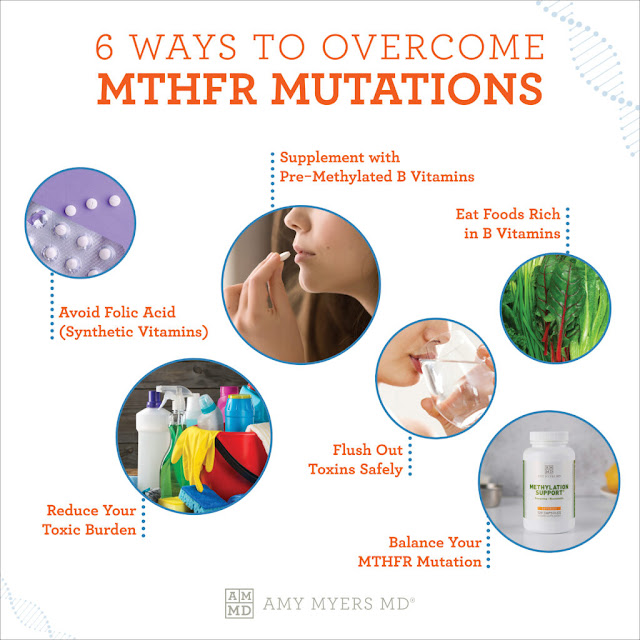MTHFR Protocol - Chris Masterjohn, PhD

MTHFR does all these things by helping us make methylfolate, a critical part of the methylation system. If you have a poorly functioning MTHFR, this is not the diagnosis of a disease or a sentence to poor health. It just means you need to adapt your food and supplements to better support your genetics. This protocol is meant to support the nutritional needs of someone with any of the genetic variations that hurt MTHFR activity. By default, the amounts of foods and nutrients are meant for someone with the genetic variation known as C677T +/+, but I will be providing instructions for further tailoring it to your own genetics and your own response to foods and supplements. The essentials are presented first, then how to get the nutrients from foods or supplements, then some information on personalizing the protocol and tailoring it to your own unique needs.
The Essentials
Here are the most essential components of the protocol:
- 5 milligrams per day (mg/d) of riboflavin (vitamin B2). Riboflavin helps improve the ability of MTHFR to make methylfolate.
- 500 milligrams of trimethylglycine (TMG) taken twice a day. TMG acts as an alternative to methylfolate and helps you get around a poorly functioning MTHFR.
- 5 grams of creatine per day. Creatine helps reduce the need for methylfolate.
- 400-600 micrograms per day (mcg/d) of dietary folate equivalents (DFE) from food with an optional addition of 400 mcg DFE supplemental methylfolate taken twice a day. Folate should be spread out across meals as much as possible to ensure there is always some methylfolate present in your system.
- 3 grams of glycine per meal. Glycine helps stabilize the methylation system, preventing swings back and forth in mood, mental state, and energy. Low methylfolate levels lead to glycine loss, so glycine is here to replace what is lost.
How to Get the Essentials from Food and Supplements
- Mainly providing choline: 1 tablespoon of lecithin; 40 grams of beef liver; 44 grams of veal liver; 62 grams of turkey liver; 71 grams of chicken liver; 143 grams of salmon; 135 to 285 grams of most meat, fish, or shellfish; 172 grams of flax seeds; 185 grams of pistachios, quinoa, amaranth, or pinto beans; 215 grams of pumpkin or squash seeds, or cashews; 250 grams of pine nuts, edamame, buckwheat, sunflower seeds, peanuts, or almonds.
- Mainly providing TMG: 24 grams of quinoa; 25 grams of wheat germ; 37 grams of wheat bran; 44 grams of raw lambsquarters; 57 grams of canned beets; 83 grams of dark rye flour; 105 grams of frozen spinach; 112 grams of raw beets; 140 grams of whole wheat flour; 143 grams of raw kamut.
The Many Other Nutrients You Need
- Diversify your protein among meat, fish, shellfish or other invertebrates, eggs, and dairy. Get a half gram to a gram of protein per pound of bodyweight (if overweight, reduce this to your ideal bodyweight), which for a 150-pound person would be 75-150 grams of protein. Most people have plenty of wiggle room within this range, but if you are trying to lose body fat, gain muscle, or meet athletic goals, you should aim for the higher side of the range (and in some cases higher).
- Make an effort to eat “nose to tail” by utilizing parts of the animals we’ve been neglecting in our society. For example, try eating liver once a week and using bones to make broths, gravies, and sauces or eating the edible bones found in canned fish.
- Get about 1000 milligrams of calcium per day, which is easiest to get from several daily servings of dairy or edible bones, such as the ones found in canned fish.
- Diversify your carbohydrates among legumes, whole grains, starchy tubers, and fruits.
- Eat a large volume (several cups per day) of vegetables, diversifying them across colors with an emphasis on red, orange, yellow, and green. Always include dark green vegetables in the daily mix.
- Include foods or supplements that aid in digestion at every meal. Examples include ginger, lacto-fermented vegetables, kombucha, raw apple cider vinegar, Swedish bitters and digestive enzyme supplements. The reasoning behind this one is simple: all those nutrient in your food are only useful if you digest your food well, breaking it down fully and absorbing everything it has to offer.


.png)





Comments
Post a Comment